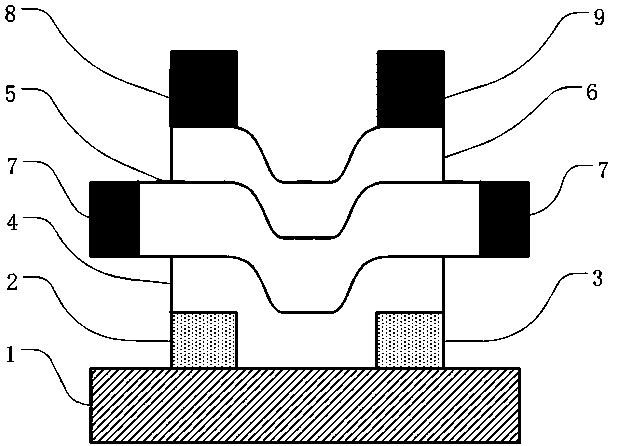Organic electroluminescent and laser luminescent device based on double TFT modulation and manufacturing method thereof
A light-emitting device and electroluminescence technology, applied in the fields of microelectronics and materials science
- Summary
- Abstract
- Description
- Claims
- Application Information
AI Technical Summary
Problems solved by technology
Method used
Image
Examples
preparation example Construction
[0037] A method for preparing an organic electroluminescent and laser light-emitting device based on double TFT modulation, comprising the following steps:
[0038] a. On the transparent substrate 1, by magnetron sputtering method, two conductive electrodes with high work function, the hole transport layer source 2 and the hole transport layer drain 3, are deposited;
[0039] b. On the two electrodes and the transparent substrate 1, a hole transport layer 4 is formed by vacuum evaporation or spin coating;
[0040] c. On the hole transport layer 4, grow a light emitting layer 5 by vacuum evaporation or spin coating;
[0041] d. On the growing luminescent layer 5, grow the electron transport layer 6 by vacuum evaporation or spin coating;
[0042] e. On the electron transport layer 6, grow an electron transport layer drain 8 and an electron transport layer source 9 with a lower work function by vacuum evaporation, and grow a lower work function on both sides of the light emittin...
Embodiment 1
[0044] A transparent glass substrate is selected, and two ITO hole transport layer source electrodes and hole transport layer drain electrodes are grown by magnetron sputtering. N, N-bis-(naphthyl)-N, N'-diphenyl-1, 1 The hole transport layer made of '-biphenyl-4, 4'-diamine (NPB) was replaced by vacuum evaporation on a 3 cm wide × 2.5 cm long mask, and 4,4'-bis (9-carbazolyl)biphenyl (CBP) as host doped with Ir(ppy) 3 [fac-tris(2-phenylpyridine)iridium]is the light-emitting layer co-evaporated and doped with 10% of the guest, and was replaced with a 2 cm wide×2.5 cm long mask to grow with 1,3,5-tris(2-N- The electron transport layer of the material of phenylbenzimidazolyl) benzene (TPBi), replaces the mask plate again, grows four aluminum electrodes by the method of vacuum evaporation and is divided into as the light-emitting layer 5 both sides of growth light-emitting layer draw-out electrode 7, the electron transport layer drain electrode 8 and electron transport layer so...
Embodiment 2
[0051] A transparent glass substrate is selected, and two ITO hole transport layer source electrodes and hole transport layer drain electrodes are grown by magnetron sputtering. N, N-bis-(naphthyl)-N, N'-diphenyl-1, 1 '-biphenyl-4, 4'-diamine (NPB) is used as the hole transport layer of the material, and the reticle is replaced by the method of vacuum evaporation on the reticle with a width of 3 cm and a length of 2.5 cm, and Alq 3 Emitting layer doped with DCJTB [4-(dicyanomethyene)-2-t-butyl-6(1,1,7,7-tetramethyljulolidyl-9-enyl)-4H-pyran] as host and 2% co-evaporated as guest , replace it with a 2 cm wide × 2.5 cm long mask to grow an electron transport layer made of Bphen (4,7-diphenyl-1,10-phenanthroline), replace the mask again, and grow by vacuum evaporation The four aluminum electrodes are divided into lead-out electrodes 7 for growing the light-emitting layer on both sides of the light-emitting layer 5 , drain electrodes 8 of the electron-transport layer and source e...
PUM
 Login to View More
Login to View More Abstract
Description
Claims
Application Information
 Login to View More
Login to View More - Generate Ideas
- Intellectual Property
- Life Sciences
- Materials
- Tech Scout
- Unparalleled Data Quality
- Higher Quality Content
- 60% Fewer Hallucinations
Browse by: Latest US Patents, China's latest patents, Technical Efficacy Thesaurus, Application Domain, Technology Topic, Popular Technical Reports.
© 2025 PatSnap. All rights reserved.Legal|Privacy policy|Modern Slavery Act Transparency Statement|Sitemap|About US| Contact US: help@patsnap.com


